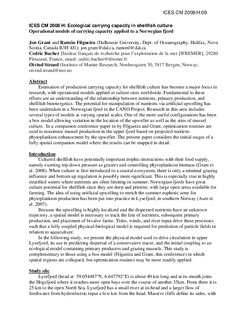| dc.contributor.author | Bacher, Cedric | |
| dc.contributor.author | Filgueira, Ramón | |
| dc.contributor.author | Grant, Jon | |
| dc.contributor.author | Strand, Øivind | |
| dc.date.accessioned | 2012-02-07T08:32:17Z | |
| dc.date.available | 2012-02-07T08:32:17Z | |
| dc.date.issued | 2008 | |
| dc.identifier.citation | This report is not to be quoted without prior consultation with the General Secretary. | no_NO |
| dc.identifier.uri | http://hdl.handle.net/11250/102694 | |
| dc.description.abstract | Estimation of production carrying capacity for shellfish culture has become a major focus in
research, with operational models applied at culture sites worldwide. Fundamental to these
efforts are an understanding of the relationship between nutrients, primary production, and
shellfish bioenergetics. The potential for manipulation of nutrients via artificial upwelling has
been undertaken in a Norwegian fjord in the CANO Project. Research in this area includes
several types of models at varying spatial scales. One of the more useful configurations has been
a box model allowing variation in the location of the upweller as well as the sites of mussel
culture. In a companion conference paper in by Filgueira and Grant, optimization routines are
used to maximize mussel production in the upper fjord based on projected nutrientphytoplankton
enhancement by the upweller. The present paper considers the initial stages of a
fully spatial companion model where the results can be mapped in detail. | no_NO |
| dc.language.iso | eng | no_NO |
| dc.publisher | ICES | no_NO |
| dc.relation.ispartofseries | ICES CM documents;2008/H:09 | |
| dc.subject | ecosystem models | no_NO |
| dc.subject | økosystemmodeller | no_NO |
| dc.title | Ecological carrying capacity in shellfish culture Operational models of carrying capacity applied to a Norwegian fjord | no_NO |
| dc.type | Working paper | no_NO |
| dc.subject.nsi | VDP::Mathematics and natural science: 400::Zoology and botany: 480::Ecology: 488 | no_NO |
| dc.source.pagenumber | 4 s. | no_NO |
